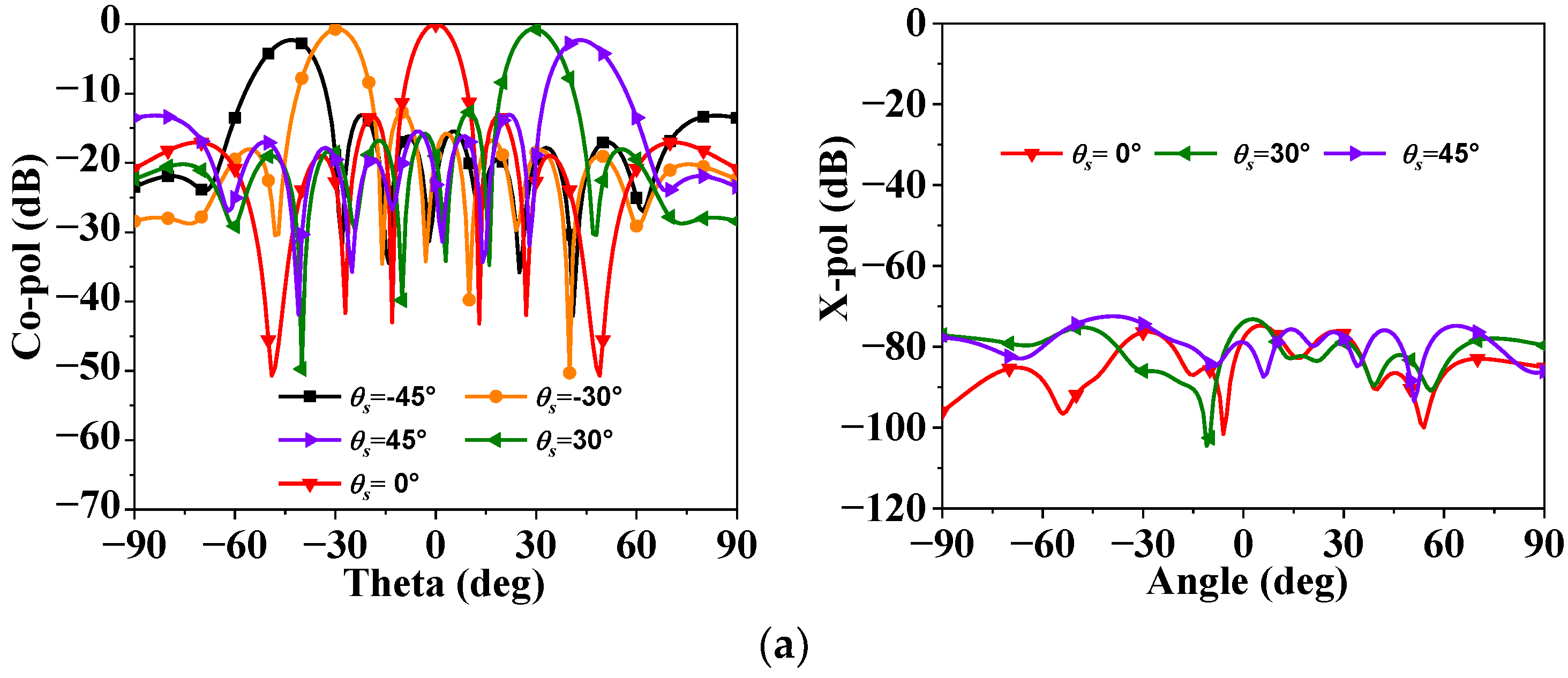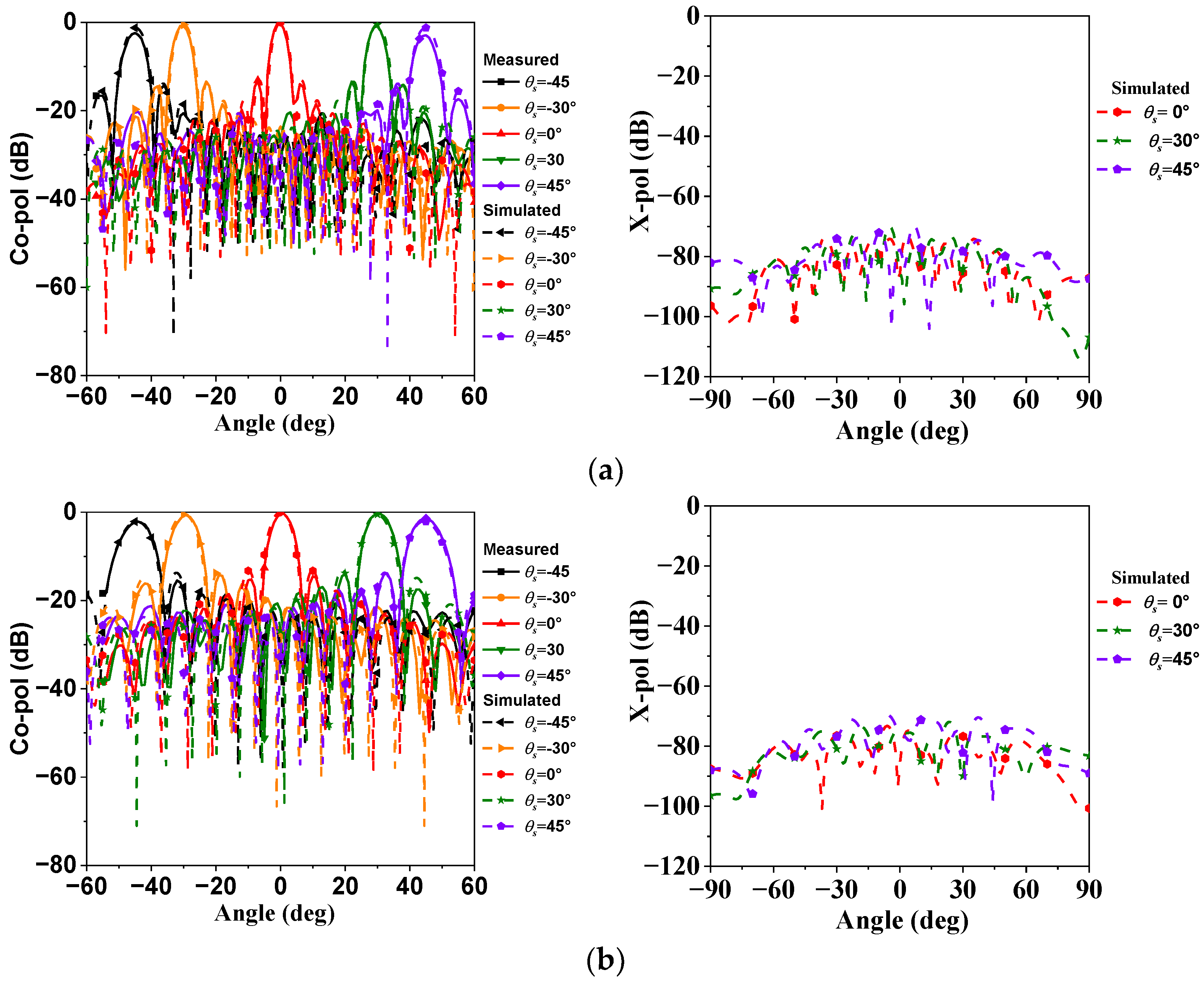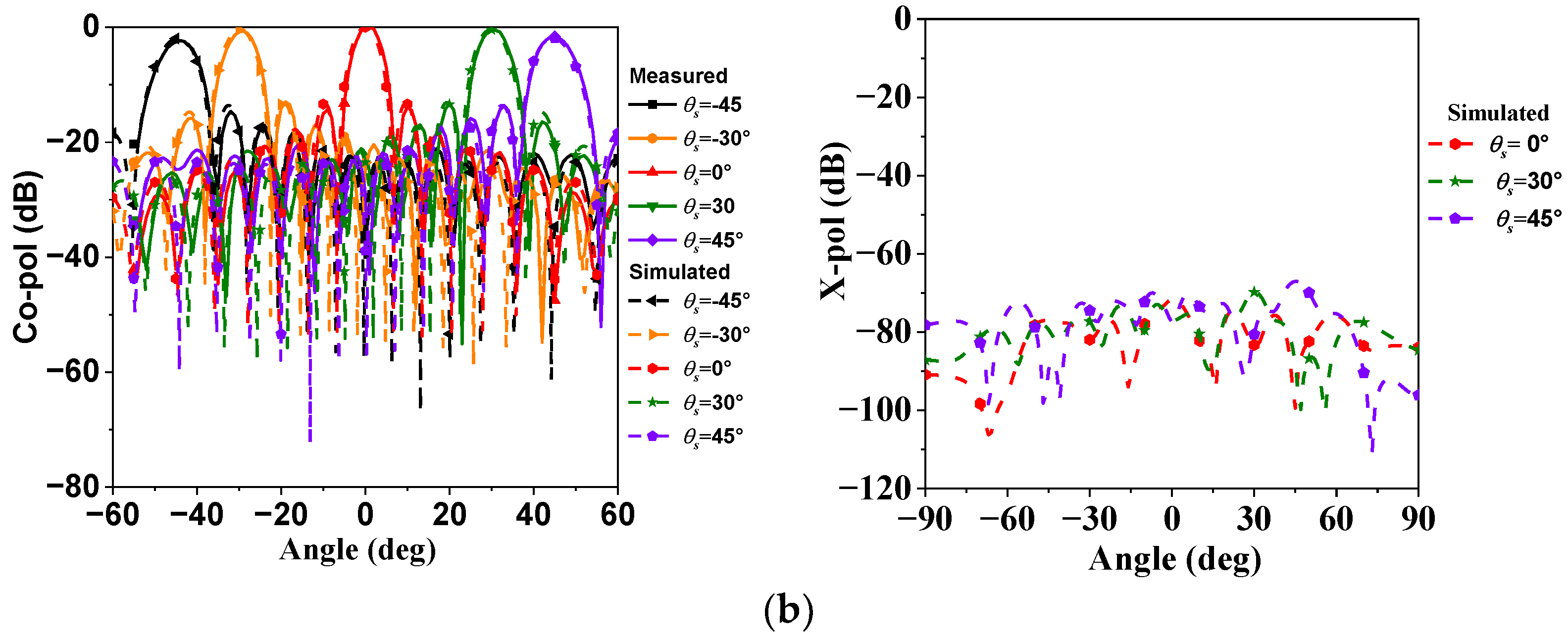Improving Scanning Performance of Patch Phased Array Antenna by Using a Modified SIW Cavity and Sequential Rotation Technique
Abstract
:1. Introduction
2. Design Requirement
- Working band: Ku band;
- Operational fractional bandwidth: 6% (0.98f0~1.03 f0);
- Element space: 0.53λ0 (λ0 is free space wavelength at f0);
- Scanning coverage: 2D;
- Scanning region: −45° to +45°;
- No scan blindness in the scan angle;
- Gain fluctuation: ≤3 dB;
- Polarization: linear polarization.
3. Infinite Array Performance
4. Methods for Improving Scanning Performance
5. Finite Array Experimental Results
6. Conclusions
Author Contributions
Funding
Data Availability Statement
Conflicts of Interest
References
- Hu, C.; Wang, B.; Gao, G.; Wang, R.; Xiao, S.; Ding, X. Conjugate Impedance Matching Method for Wideband and Wide-Angle Impedance Matching Layer With 70° Scanning in the H-Plane. IEEE Antennas Wirel. Propag. Lett. 2021, 20, 63–67. [Google Scholar] [CrossRef]
- Zeng, Q.; Chen, Z.; He, M.; Wang, S.; Liu, X.; Xu, H. Design of a Ka-Band Heterogeneous Integrated T/R Module of Phased Array Antenna. Electronics 2024, 13, 204. [Google Scholar] [CrossRef]
- Hu, C.; Wang, B.; Wang, R.; Xiao, S.; Ding, X. Ultrawideband, Wide-Angle Scanning Array with Compact, Single-Layer Feeding Network. IEEE Trans. Antennas Propag. 2020, 68, 2788–2796. [Google Scholar] [CrossRef]
- Yang, G.; Li, J.; Wei, D.; Xu, R. Study on Wide-Angle Scanning Linear Phased Array Antenna. IEEE Trans. Antennas Propag. 2018, 66, 450–455. [Google Scholar] [CrossRef]
- Xu, Z.; Zhang, C.; Kaufmann, T.; Yan, X.; Yuan, Y.; Fumeaux, C. Analysis of Scan Blindness in a Linearly Polarized Tapered-Slot Phased Array in Triangular Lattice—Performance Improvement with Parasitic Notches. IEEE Trans. Antennas Propag. 2014, 62, 4057–4066. [Google Scholar] [CrossRef]
- Jin, F.; Ding, X.; Cheng, Y.; Wang, B.; Shao, W. A Wideband Phased Array with Broad Scanning Range and Wide-Angle Impedance Matching. IEEE Trans. Antennas Propag. 2020, 68, 6022–6031. [Google Scholar] [CrossRef]
- Jin, F.; Ding, X.; Cheng, Y.; Wang, B.; Shao, W. Impedance Matching Design of a Low-Profile Wide-Angle Scanning Phased Array. IEEE Trans. Antennas Propag. 2019, 67, 6401–6409. [Google Scholar] [CrossRef]
- Sun, D.; Hao, Z.; Ding, C.; Liu, R.; Guo, Z.; Yin, H. A Low-Profile Ultra-Wideband and Wide-Scanning Phased Array for UHF Applications. IEEE Trans. Antennas Propag. 2023, 71, 473–486. [Google Scholar] [CrossRef]
- Bermúdez-Martín, D.; Gillard, R.; Molero, C.; Legay, H.; García-Vigueras, M. Methodology for Improving Scanning Performance Loading an Array Element with a 3D All-Metal WAIM. Electronics 2022, 11, 2848. [Google Scholar] [CrossRef]
- Vilenskiy, A.; Litun, V.; Lyulyukin, K. Wideband Beam Steering Antenna Array of Printed Cavity-Backed Elements With Integrated EBG Structure. IEEE Antennas Wirel. Propag. Lett. 2019, 18, 245–249. [Google Scholar] [CrossRef]
- Kiani-Kharaji, M.; Hassani, H.; Mohammad-Ali-Nezhad, S. Wide scan phased array patch antenna with mutual coupling reduction. IET Microw. Antennas Propag. 2018, 12, 1932–1938. [Google Scholar] [CrossRef]
- Yang, G.; Li, J.; Xu, R.; Ma, Y.; Qi, Y. Improving the Performance of Wide-Angle Scanning Array Antenna with a High-Impedance Periodic Structure. IEEE Antennas Wirel. Propag. Lett. 2016, 15, 1819–1822. [Google Scholar] [CrossRef]
- Sun, B.; Ding, X.; Cheng, Y.; Shao, W. 2-D Wide-Angle Scanning Phased Array with Hybrid Patch Mode Technique. IEEE Antennas Wirel. Propag. Lett. 2020, 19, 700–704. [Google Scholar] [CrossRef]
- Wang, Y.; Ding, X.; Zhang, L.; Shao, W.; Wang, B. A Low-Cost Wideband Dual Circularly Polarized Aperiodic 2-D Phased Array. IEEE Trans. Antennas Propag. 2023, 71, 3080–3090. [Google Scholar] [CrossRef]
- Guo, J.; Hu, Y.; Hong, W. A 45° Polarized Wideband and Wide-Coverage Patch Antenna Array for Millimeter-Wave Communication. IEEE Trans. Antennas Propag. 2022, 70, 1919–1930. [Google Scholar] [CrossRef]
- Liu, H.; Qing, A.; Xu, Z.; Yu, Z.; Zhang, S. Design of Physically Connected Wideband SIW Cavity-Backed Patch Antenna for Wide-Angle Scanning Phased Arrays. IEEE Antennas Wirel. Propag. Lett. 2021, 20, 406–410. [Google Scholar] [CrossRef]
- Cheng, Y.; Ding, X.; Shao, W.; Wang, B. Planar Wide-Angle Scanning Phased Array with Pattern-Reconfigurable Windmill-Shaped Loop Elements. IEEE Trans. Antennas Propag. 2017, 65, 932–936. [Google Scholar] [CrossRef]
- Xia, R.; Qu, S.; Li, P.; Yang, D.; Yang, S.; Nie, Z. Wide-Angle Scanning Phased Array Using an Efficient Decoupling Network. IEEE Trans. Antennas Propag. 2015, 63, 5161–5165. [Google Scholar] [CrossRef]
- Xia, R.L.; Qu, S.W.; Yang, S.; Chen, Y. Wideband Wide-Scanning Phased Array with Connected Backed Cavities and Parasitic Striplines. IEEE Trans. Antennas Propag. 2018, 66, 1767–1775. [Google Scholar] [CrossRef]
- Rodríguez Ulibarri, P.; Crépin, T.; Martel, C.; Boust, F.; Falcone Lanas, F.J.; Loecker, C.; Herbertz, K.; Bertuch, T.; Dousset, T.; Martinaud, J.P.; et al. Experimental demonstration of metamaterials application for mitigating scan blindness in phased array antennas. EPJ Appl. Metamaterials 2016, 3, 9. [Google Scholar] [CrossRef]
- Aljuhani, A.; Kanar, T.; Zihir, S.; Rebeiz, G. A 256-Element Ku-Band Polarization Agile SATCOM Receive Phased Array with Wide-Angle Scanning and High Polarization Purity. IEEE Trans. Microw. Theory Tech. 2021, 69, 2609–2628. [Google Scholar] [CrossRef]
- Aljuhani, A.; Kanar, T.; Zihir, S.; Rebeiz, G. A 256-Element Ku-Band Polarization Agile SATCOM Transmit Phased Array with Wide-Scan Angles, Low Cross Polarization, Deep Nulls, and 36.5-dBW EIRP per Polarization. IEEE Trans. Microw. Theory Tech. 2021, 69, 2594–2608. [Google Scholar] [CrossRef]
- Low, K.; Zihir; Kanar, T.; Rebeiz, G. A 27–31-GHz 1024-Element Ka-Band SATCOM Phased-Array Transmitter With 49.5-dBW Peak EIRP, 1-dB AR, and ±70° Beam Scanning. IEEE Trans. Microw. Theory Tech. 2022, 70, 1757–1768. [Google Scholar] [CrossRef]
- Banerjee, R.; Sharma, S.K.; Waldstein, S.W.; Downey, J.M.; Schoenholz, B.L.; Dever, S.M.; Nessel, J.A.; Das, S. A 22-28 GHz Polarization-Reconfigurable Flat-Panel 8 × 8 Tx/Rx Phased Array Antenna with Uniquely Arranged Novel Radiating Elements for CubeSat Communication. IEEE Trans. Antennas Propag. 2023, 73, 4138–4152. [Google Scholar] [CrossRef]
- Awida, M.; Kamel, A.; Fathy, A. Analysis And Design of Wide-Scan Angle Wide-Band Phased Arrays of Substrate-Integrated Cavity-Backed Patches. IEEE Trans. Antennas Propag. 2013, 61, 3034–3041. [Google Scholar] [CrossRef]
- Valavan, S.; Tran, D.; Yarovoy, A.; Roederer, A. Planar Dual-Band Wide-Scan Phased Array in X-Band. IEEE Trans. Antennas Propag. 2014, 62, 5370–5375. [Google Scholar] [CrossRef]
- Ortiz, J.A.; Salazar-Cerreno, J.L.; Díaz, J.D.; Lebrón, R.M.; Aboserwal, N.A.; Jeon, L. Low-cost CMOS Active Array Solution for Highly Dense X-Band Weather Radar Network. IEEE Trans. Antennas Propag. 2020, 68, 5421–5430. [Google Scholar] [CrossRef]
- Saeidi-Manesh, H.; Zhang, G. Challenges and Limitations of The Cross-Polarization Suppression in Dual-Polarization Antenna Arrays Using Identical Subarrays. IEEE Trans. Antennas Propag. 2020, 68, 2853–2866. [Google Scholar] [CrossRef]
- Ludwig, A. The definition of cross polarization. IEEE Trans. Antennas Propag. 1973, 21, 116–119. [Google Scholar] [CrossRef]
- Hampson, G.; Smolders, A. A Fast and Accurate Scheme for Calibration of Active Phased-Array Antennas. In Proceedings of the IEEE Antennas and Propagation Society International Symposium. 1999 Digest. Held in conjunction with: USNC/URSI National Radio Science Meeting (Cat. No.99CH37010), Orlando, FL, USA, 11–16 July 1999; Volume 2, pp. 1040–1043. [Google Scholar]

















| Work | Peak Gain/dBi | Scan Loss/dB (45°/−45°) | Blind Spot | X-Pol Level/dB (45°/−45°) | Pattern |
|---|---|---|---|---|---|
| Array 1 | 23.7 | E: 2.3/3.8 H: 3.3/3.3 | @1.06f0 | E: −66.2 H: −5.32 | Asymmetry |
| Array 2 | 23.7 | E: 2.1/2.6 H: 2.3/2.8 | @1.09f0 | E: −73.1 H: −8.97 | Asymmetry |
| Array 3 | 23.6 | E: 2.3/2.3 H: 2.1/2.1 | @1.09f0 | E: −75.5 H: −74.5 | Symmetry |
| Simulated | Measured | |||
|---|---|---|---|---|
| Frequency | E-Plane | H-Plane | E-Plane | H-Plane |
| fl | 1.23 dB @±45° | 2.06 dB @±45° | 2.9 dB @±45° | 2.14 dB @±45° |
| f0 | 1.45 dB @±45° | 1.92 dB @±45° | 2.9 dB @±45° | 2.9 dB @±45° |
| fh | 1.98 dB @±45° | 1.8 dB @±45° | 3.8 dB @±45° | 3.7 dB @±45° |
| Work | Gain Fluctuation | -Pol Level/dB (45°/−45°) | Approaches | Pattern |
|---|---|---|---|---|
| [15] | E: 3dB @±45° H: 3 dB @±45° | - | SIW cavity | Symmetry |
| [16] | E: 0.5dB @±15° H: 3 dB @±45° | E: −64 dB @45° H: −14 dB @45° | SIW cavity | Asymmetry |
| [21] | E: 4.1 dB @±60° H: 5.2 dB @±60° | E: −29 dB @60° H: −23 dB @60° | SQT | Symmetry |
| This work | E: 2.9 dB @±45° H: 2.2 dB @±45° | E: −72.3 dB @45° H: −68.1 dB @45° | SQT and SIW cavity | Symmetry |
Disclaimer/Publisher’s Note: The statements, opinions and data contained in all publications are solely those of the individual author(s) and contributor(s) and not of MDPI and/or the editor(s). MDPI and/or the editor(s) disclaim responsibility for any injury to people or property resulting from any ideas, methods, instructions or products referred to in the content. |
© 2024 by the authors. Licensee MDPI, Basel, Switzerland. This article is an open access article distributed under the terms and conditions of the Creative Commons Attribution (CC BY) license (https://creativecommons.org/licenses/by/4.0/).
Share and Cite
Liu, H.; Guan, T.; Fu, C.; Zhang, S.; Xu, X.; Xu, Z.; Qing, A.; Lin, X. Improving Scanning Performance of Patch Phased Array Antenna by Using a Modified SIW Cavity and Sequential Rotation Technique. Electronics 2024, 13, 1776. https://doi.org/10.3390/electronics13091776
Liu H, Guan T, Fu C, Zhang S, Xu X, Xu Z, Qing A, Lin X. Improving Scanning Performance of Patch Phased Array Antenna by Using a Modified SIW Cavity and Sequential Rotation Technique. Electronics. 2024; 13(9):1776. https://doi.org/10.3390/electronics13091776
Chicago/Turabian StyleLiu, Hao, Tianci Guan, Chunsen Fu, Shuqi Zhang, Xin Xu, Ziqiang Xu, Anyong Qing, and Xianqi Lin. 2024. "Improving Scanning Performance of Patch Phased Array Antenna by Using a Modified SIW Cavity and Sequential Rotation Technique" Electronics 13, no. 9: 1776. https://doi.org/10.3390/electronics13091776





